| THINK |

THE STORY OF IBM
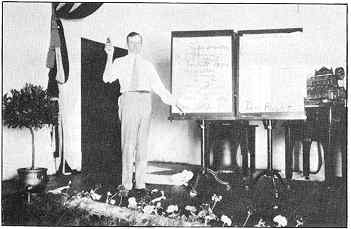
Thomas J. Watson, Sr. (above lectures his NCR sales force on
"The Five C's: Conception, Consistancy, Cooperation, Courage
and Confidence. His desk at NCR (below) Exemplifies his
compulsion for cleanliness.
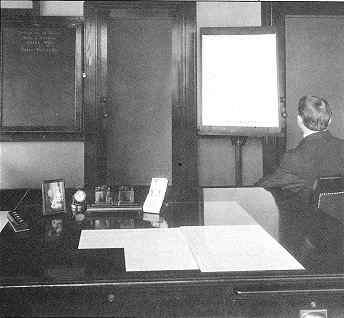
Thanks to the management style of Thomas J. Watson, Sr., the early IBM was run much like a fundamentalist religion. Watson, for forty years the organization's patriarch, favored sales conventions on the order of revival meetings, complete with group singing and inspirational slogans; originally known as the Computing-Tabulating-Recording Company (CTR), his firm was run to the tune of ditties like:
Mr.
Watson is the man we're working for
He's the leader of the CTR
He's the fairest, squarest man we know.
He's the leader of the CTR
He's the fairest, squarest man we know.
Today Watson's paternalistic outlook has proved influential far beyond his own empire: the current successful Japanese management culture is based on IBM's policies.
Born in 1874 to a tough lumberjack and his wife, Thomas Watson learned from life on the farm in Painted Post, New York, the basic ideas that he later instilled in thousands of his own workers. These were later described by his son as follows: "to do every job well, to treat all people with dignity and respect, to appear neatly dressed, to be clean and forthright, to be eternally optimistic, and above all, loyal."
After a few false starts in local businesses and a stint as a traveling salesman, Watson shuffled off to Buffalo-where he joined National Cash Register Corp. and soon rose to the third most powerful position in the firm. When NCR was prosecuted for antitrust violations, Watson was convicted even though he had little to do with the company's suspect practices; the conviction was later reversed on appeal, but it left its mark on his psyche. Less than six months later, he was fired for disagreeing with NCR president John H. Patterson in front of other company executives.
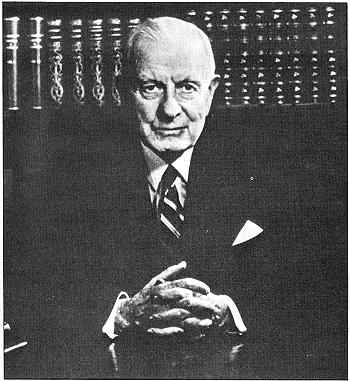
Watson then joined the firm soon to be known as International Business Machines (IBM). As its chief executive officer by 1924, the year of its fateful name change, Watson began to imprint his distinctive personality on the entire company. The strict dress code (dark suit and white shirt), which Watson himself observed by never taking off his jacket on even the hottest day, was the result of his desire to lend respectability to the then lowly position of salesman. (This from a man whose dress style at NCR had been distinguished by a penchant for wearing white socks!)
Watson's IBM faced hard times during the Depression but was saved from disaster by New Deal legislation like the Social Security Act and the Wage-Hours Act of 1937-38 that required more sophisticated record keeping. When World War II broke out, Watson gave IBM over to the U.S. military effort. Besides performing accounting tasks for the government, the corporation produced rifle and aircraft engine parts in its factories.
It was during the war that IBM entered the computer business, backing Prof. Howard Aiken at Harvard University to build the computer that would be considered "Babbage's dream come true." On the eve of the presentation ceremony, Aiken reportedly introduced the Mark I computer to the press without even mentioning IBM's or Watson's part in its development. As a man who enjoyed his due credit (he came up with the slogan THINK as an inexpensive source of publicity, then saw it become the most widely quoted corporate slogan in history), Watson is said to have raged at Aiken: "You can't put IBM on as a postscript! I think about IBM just as you Harvard fellows do about your university."
The event did, however, spur Watson and IBM to build a machine that would eclipse the Mark I. IBM's first computer, the Selective Sequence Electronic Calculator, was unveiled in 1948, proving a far more powerful machine than any others of its time.
In 1952 Thomas J. Watson, Jr., became IBM's president. Four years later, a month after reluctantly turning his CEO reins over to his son, Thomas Sr. died of a heart attack at the age of eighty-two.
MARGUERITE ZIENTARA
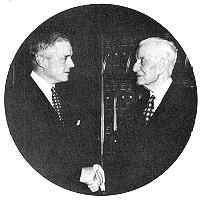
Above left: the official portrait of Thomas J. Watson, Sr., as CEO of IBM. Shown here: Watson turning over the company to Thomas Jr.
IBM TODAY
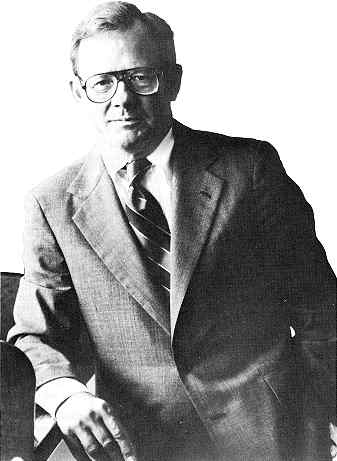
Chairman and Chief Executive Officer John R. Opel presides over a company that is first in the United States in profits ($5.5 billion in 1983) and third in total employees (370,000 worldwide), with offices in 132 countries. Despite antitrust suits on several continents, IBM has continued to thrive. Big Blue is the most important institutionally held stock on Wall Street. As IBM goes, so goes the Dow Jones Industrial Average.
Personal computers account for only a fraction of IBM's sales. The company remains preeminent in the area of mainframe computers, as well as setting the standard for electric office typewriters with its classic Selectric series. Though "THINK" has been retired as a corporate motto, there remains the same involvement with its personnel (pictured here the IBM country club near Endicott, New York) originated by Thomas J. Watson, Sr.
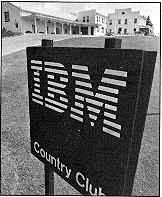

Return to Table of Contents | Previous Article | Next Article

